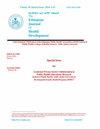Risk factors of neonatal mortality in Ethiopia.
IF 0.4
4区 医学
Q4 PUBLIC, ENVIRONMENTAL & OCCUPATIONAL HEALTH
引用次数: 31
Abstract
Abstract Background: An understanding of risk factors related to neonatal mortality is important to guide the development of focused and evidence-based health interventions to reduce neonatal deaths. Objective: This study aimed to identify risk factors of neonatal mortality in Ethiopia. Methods: The data source for the study was the 2011 Ethiopian Demographic and Health Survey. The survival information of a total of 8,651 live-born neonates born five years before the survey was examined. Stratified Cox-proportional hazards model was employed to identify risk factors associated with neonatal deaths. Results: About 71% of the neonatal deaths occurred within the first week after birth and, the cumulative death rate reached 79% in the second week. The estimated hazard ratios of mortality were higher for twins or multiple births (HR=3.73, 95% CI: 2.81-4.94), first order birth (HR=1.68, 95% CI: 1.25-2.24), male sex (HR=1.26, 95% CI: 1.06-1.50), birth interval shorter than 24 months (HR=1.63, 95% CI:1.31-2.03), very small and vary large size neonates born to mothers younger than 20 years of age and above 34 years (HR=1.38, 95% CI:1.05-1.82) and (HR=1.32, 95% CI 0.06-2.80), respectively, and neonates whose mothers had a history of pregnancy complications (HR=1.73, 95% CI: 1.27-2.24) compared to their respective counterparts. The risk of dying was lower for neonates whose mothers attended antenatal visits (HR=0.72, 95% CI: 0.59-0.89) and neonates put to breast immediately upon birth (HR=0.83, 95% CI: 0.59-0.99). Conclusion: Public health interventions directed at reducing neonatal death should address the demographic factors mentioned above and maternal health services. [Ethiop. J. Health Dev. 2013;27(3):192-199]埃塞俄比亚新生儿死亡的危险因素。
背景:了解与新生儿死亡率相关的危险因素对于指导有针对性和基于证据的卫生干预措施的发展以减少新生儿死亡具有重要意义。目的:本研究旨在确定埃塞俄比亚新生儿死亡的危险因素。方法:本研究的数据来源为2011年埃塞俄比亚人口与健康调查。对调查前5年出生的8651名活产新生儿的生存信息进行了检查。采用分层cox -比例风险模型确定与新生儿死亡相关的危险因素。结果:新生儿死亡约71%发生在出生后第1周,第2周累计死亡率达79%。双胞胎或多胞胎(HR=3.73, 95% CI: 2.81-4.94)、第一胎(HR=1.68, 95% CI: 1.25-2.24)、男性(HR=1.26, 95% CI:1.06-1.50),出生间隔小于24个月(HR=1.63, 95% CI:1.31-2.03),小于20岁和大于34岁的母亲所生的新生儿(HR=1.38, 95% CI:1.05-1.82)和(HR=1.32, 95% CI: 0.06-2.80),以及母亲有妊娠并发症史的新生儿(HR=1.73, 95% CI: 1.27-2.24)与各自的同行相比。母亲参加产前检查(HR=0.72, 95% CI: 0.59-0.89)和新生儿出生后立即母乳喂养(HR=0.83, 95% CI: 0.59-0.99)的新生儿死亡风险较低。结论:旨在降低新生儿死亡率的公共卫生干预措施应解决上述人口因素和孕产妇保健服务问题。[阿比西尼亚人。中华卫生杂志,2013;27(3):192-199 [j]
本文章由计算机程序翻译,如有差异,请以英文原文为准。
求助全文
约1分钟内获得全文
求助全文
来源期刊

Ethiopian Journal of Health Development
PUBLIC, ENVIRONMENTAL & OCCUPATIONAL HEALTH-
CiteScore
0.80
自引率
0.00%
发文量
0
审稿时长
>12 weeks
期刊介绍:
The Ethiopian Journal of Health Development is a multi and interdisciplinary platform that provides space for public health experts in academics, policy and programs to share empirical evidence to contribute to health development agenda.
We publish original research articles, reviews, brief communications and commentaries on public health issues, to inform current research, policy and practice in all areas of common interest to the scholars in the field of public health, social sciences and humanities, health practitioners and policy makers. The journal publishes material relevant to any aspect of public health from a wide range of fields: epidemiology, environmental health, health economics, reproductive health, behavioral sciences, nutrition, psychiatry, social pharmacy, medical anthropology, medical sociology, clinical psychology and wide arrays of social sciences and humanities.
The journal publishes the following types of contribution:
1) Peer-reviewed original research articles and critical or analytical reviews in any area of social public health. These papers may be up to 3,500 words excluding abstract, tables, and references. Papers below this limit are preferred.
2) Peer-reviewed short reports of research findings on topical issues or published articles of between 2000 and 4000 words.
3) Brief communications, and commentaries debating on particular areas of focus, and published alongside, selected articles.
4) Special Issues bringing together collections of papers on a particular theme, and usually guest edited.
5) Editorial that flags critical issues of public health debate for policy, program and scientific consumption or further debate
 求助内容:
求助内容: 应助结果提醒方式:
应助结果提醒方式:


